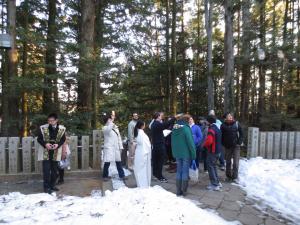The February JET study tour to Soma and Minamisoma was the third such tour I have been on, but it was certainly the one closest to my heart. Having lived in Soma for eight months at the start of my time in Japan and a subsequent year living in Minamisoma, as well as teaching in all the high schools in both cities –the Soso district feels like a second home to me. There is much I could say about this tour –each and every activity was meaningful and interesting in its own way, from picking mouth-watering strawberries at a local strawberry farm, to visiting the solar-powered Agri-Park. However, I shall endeavour to go into a little more detail of the highlights of the tour. The tour began with a lecture on the radiation produced by the Daiichi Nuclear Power Plant as a result the 3.11 disaster –this was of great interest to me as my town is dotted with Geiger counters detailing the current levels of radiation in the area. It was certainly reassuring to have my beliefs confirmed -that it is unlikely that there will be any significant lasting health effects in Fukushima due to the radiation. Similarly, it was interesting to visit Matsukawaura Bay and hear about the effects the disaster has had on local fishing. Our questions were patiently and kindly answered and I was happy –if not a little surprised after hearing constant fear-mongering for 3 years- to hear that only a few select types of fish continue to be at all affected by the radiation from the power plant. I hope that in light of this Soma’s fishing industry will be able to return to its former glory soon. Undoubtedly the most poignant part of the tour for me was the extended tour around Odaka, on the edge of the Exclusion Zone. I had been to Odaka several times to volunteer in the past, but did not have the opportunity to sightsee as extensively as on the tour. Hearing about the town before and during the disaster from the perspective of someone who was born and raised there was both fascinating and heartbreaking. Especially, stopping near the deserted coastline to look at pictures from before the tsunami and realising that the empty fields had once been the site of hundreds of houses was shocking and moving to the extreme. Despite having lived in the area for almost 2 years, I am so glad that I could participate on this trip. The more I learn of the disaster, the more I admire how strong and resilient the people are here, and the more I realise how special my little part of Fukushima is. Most importantly, once again I have been reminded just how lucky I am to have been placed in such a wonderful area. |  |
| Summary |







